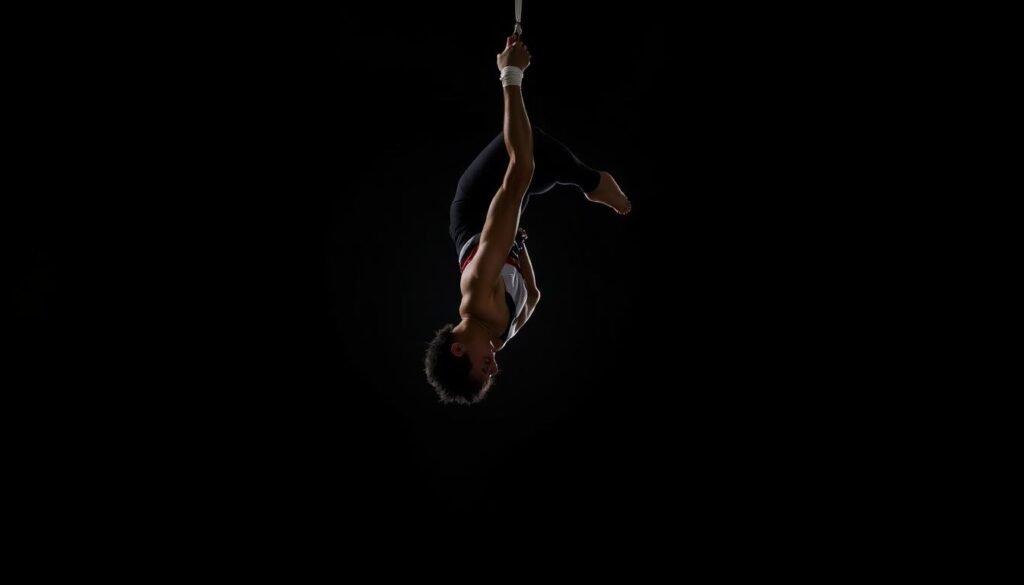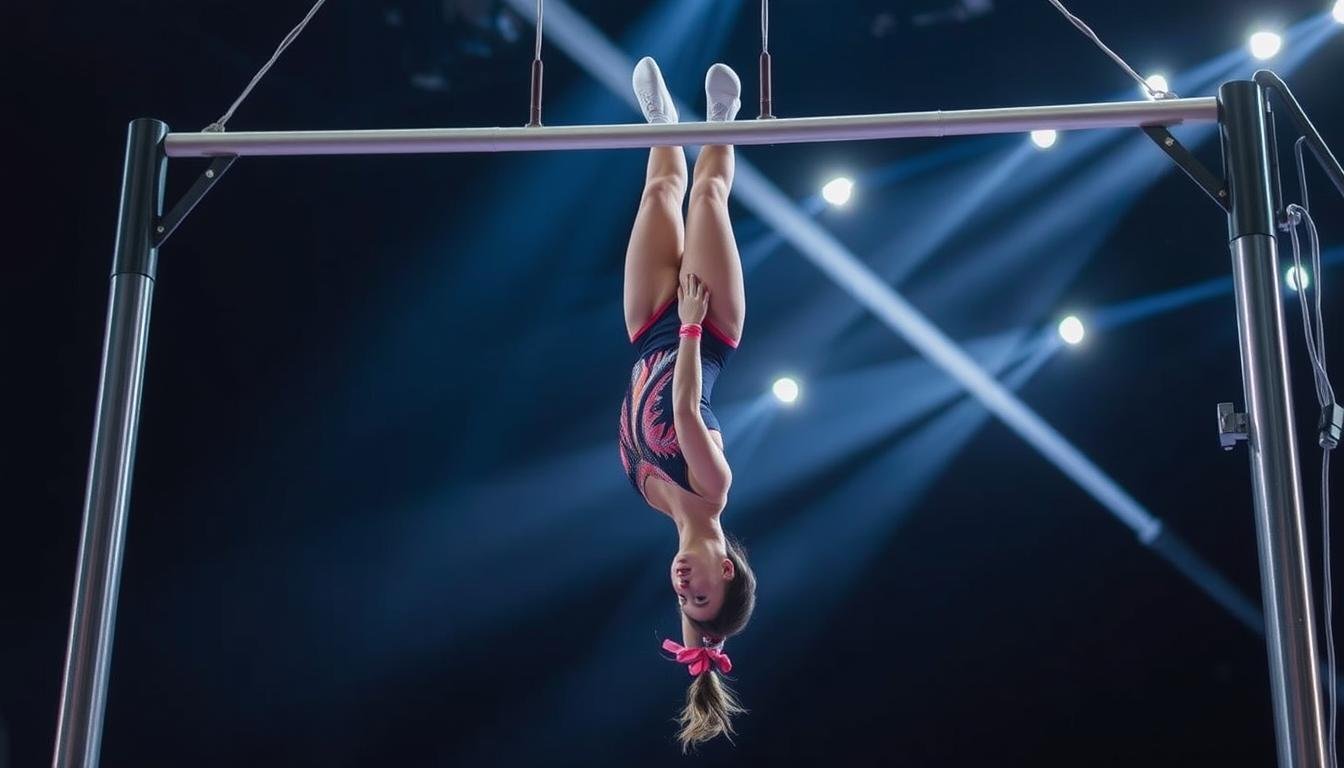Why the Korbut Flip is Considered Dangerous? Have you seen the Korbut Flip in gymnastics competitions? It’s a skill made famous by Olga Korbut in the 1970s. It’s known for its complexity and the risk of serious injury.
The Korbut Flip is a tough move that needs a lot of skill. It’s risky because of the high-flying release and the catch that follows. Even experienced gymnasts find it challenging. Let’s look into the history and technical challenges of this skill and the dangers it poses.
Contents
The History and Legacy of the Korbut Flip
The Korbut Flip changed gymnastics forever. It started with Olga Korbut’s amazing performance at the 1972 Munich Olympics. Her Korbut Flip defined her career and left a big mark on the sport.
The Korbut Flip was a big deal for women’s gymnastics. It set a new standard for uneven bar routines. It made routines more complex and daring.
The Korbut Flip’s impact is clear in gymnastics today. Gymnasts now do more complex skills and combinations. This has pushed what’s possible in the sport.
| Year | Event | Impact on Gymnastics |
|---|---|---|
| 1972 | Olga Korbut performs the Korbut Flip at the Munich Olympics | Introduced a new level of complexity to uneven bar routines |
| Late 1970s | Gymnasts begin to incorporate more complex skills and combinations | Raised the bar for competitive gymnastics routines |
| 1980s | Uneven bar routines become more dynamic and daring | Further established the uneven bars as a showcase for gymnastic innovation |
The Korbut Flip is more than just a move. It’s a symbol of gymnastics’ ability to innovate and be artistic. As you learn about gymnastics, you’ll see the Korbut Flip as a key part of its history.
In short, the Korbut Flip’s story is tied to Olga Korbut and gymnastics’ growth. It still inspires gymnasts today to try new things.
Why Is the Korbut Flip Dangerous: Technical Analysis
Doing a Korbut Flip means letting go of the uneven bar and spinning in the air. This can cause serious injuries if done wrong. It needs a lot of strength, flexibility, and coordination.
When you try a Korbut Flip, you risk not finishing the spin or not catching the bar right. This skill is hard because it needs perfect timing and control.
The Korbut Flip is tough on your body, especially your wrists, shoulders, and back. Landing or catching the bar can hurt a lot. Trying it over and over can lead to long-term injuries.
Comparison to Other Uneven Bar Skills
The Korbut Flip is harder and riskier than other uneven bar skills. Skills like the release move or Tkatchev also involve letting go of the bar. But the Korbut Flip’s spin and catch make it more dangerous.
Knowing the risks of the Korbut Flip is key for gymnasts and coaches. It helps you prepare for its challenges and reduce the dangers.
Physical Risks and Documented Injuries
The Korbut Flip is a move that has captivated audiences, but it comes with a significant risk of injury. When you attempt this complex gymnastics maneuver, you’re exposing yourself to various physical risks. These risks can have long-lasting effects on your body.
Gymnasts who perform the Korbut Flip are particularly susceptible to wrist and ankle injuries. The flip involves a backward rotation, landing on the hands, which can put immense pressure on the wrists. Repeated strain or a single misstep can lead to severe injuries, including fractures or ligament sprains. Ankle injuries are also common due to the impact of landing, which can cause strains or breaks.

Concussions are another significant risk associated with the Korbut Flip. If you misjudge the flip or land awkwardly, you might hit your head on the floor, leading to a concussion. The physical risks are not limited to the immediate impact; they can also include long-term health issues, such as chronic pain or degenerative conditions in the joints.
Documented cases of injuries from the Korbut Flip highlight the dangers gymnasts face. For instance, several high-profile gymnasts have suffered serious injuries while attempting this move in competitions. These cases underscore the importance of safety measures and proper training to mitigate the risks associated with the Korbut Flip.
To minimize the risks, gymnasts and coaches emphasize the need for thorough training, proper equipment, and safety protocols. This includes warming up extensively, using spring floors or mats to cushion landings, and having spotters present during practice and competition.
Understanding the physical risks and documented injuries related to the Korbut Flip is crucial for gymnasts, coaches, and the gymnastics community. By acknowledging these dangers, you can take steps to reduce the risks. This ensures a safer environment for athletes to perform at their best.
The Ban and Evolution of Safety in Gymnastics
The Korbut Flip’s ban was a big change in gymnastics, showing how the sport values safety more. This ban was a big deal, showing gymnastics’ new focus on athlete safety over high-risk moves.
Before the ban, worries about the Korbut Flip’s safety grew. The risk of injury was high, and many gymnasts got hurt trying it. This made gymnastics’ leaders rethink the safety of such moves.
The ban on the Korbut Flip was part of making gymnastics safer. It was not alone; new rules and safety steps were added too. These changes aimed to lower injury risks for gymnasts.
Today, gymnastics puts a lot of effort into keeping athletes safe. It’s a sport that values both competition and athlete health. Theevolution of gymnastics shows a balance between excitement and safety.
Gymnastics keeps getting safer, thanks to the Korbut Flip ban. It now uses new tech, training, and rules to protect gymnasts. This shows gymnastics’ dedication to keeping its athletes safe and healthy.
Conclusion: Why the Korbut Flip is Considered Dangerous?
The Korbut Flip has made a big impact on gymnastics. It shows the fine line between taking risks and being innovative. This balance is key in the sport.
The Korbut Flip’s story teaches us about the gymnastics legacy. It’s about athletes who dare to try new things, even if it’s risky. This legacy continues to shape how gymnasts train and compete today.
Risk and innovation are at the heart of gymnastics. The Korbut Flip’s story shows how daring moves can change the sport. They help shape its future and improve safety.
See Also: The Dangers of Exotic Animals: Why They Can Be Risky
FAQ
What is the Korbut Flip?
The Korbut Flip is a gymnastics skill done on the uneven bars. It was made famous by Olga Korbut in the 1970s.
Why is the Korbut Flip considered dangerous?
This move is risky because it’s very technical. It needs exact timing and control. It can cause serious injuries like wrist, ankle problems, and even concussions.
Who popularized the Korbut Flip?
Olga Korbut introduced the Korbut Flip at the 1972 Munich Olympics. It became a key part of her routine and raised the bar for others.
What led to the ban on the Korbut Flip in competitive gymnastics?
The ban came from safety concerns and the risk of injury. This move was banned, marking a big change in the sport.
How has the Korbut Flip influenced gymnastics?
Even though it’s not done competitively anymore, the Korbut Flip still shapes gymnastics. It shows the balance between risk and innovation in the sport.
Are there other gymnastics skills that are considered high-risk?
Yes, many skills are risky, like complex releases, twists, and landings. They require a lot of strength, flexibility, and coordination from gymnasts.

Lorenzo Sloan is a safety advocate from Los Angeles who exposes hidden and everyday dangers through research-based blogging. With a background in social work, he aims to keep readers informed, cautious, and prepared for the unexpected risks around them.

